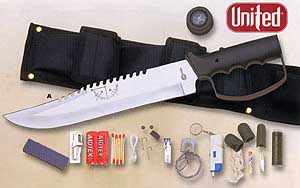Featured Member Video
Survival TarpMore Videos by IA Woodsman
View larger or ask the author a question.
View all wilderness survival videos
Recent Forum Posts 
Come Join the Discussion Today!
Our site has been mentioned in:
U.S. News and World Report
Best of the Web - Site of the Week 8/6/01
Discovery Channel Canada
One Week in the Wilderness
USA Today
Hot Sites 08/08/2005
Typhoid Fever
Alternative names: typhoid, gastric fever, slow fever (it is NOT the same at Typhus) Type of infection: bacterial Incubation period: 6 to 30 days Mortality rate: up to 30% if not treated Vector: contact with fecal contamination HistoryOne of the first recorded outbreaks of what is likely typhoid fever took place in 430 BC and wiped out a large portion of the people of Athens. It may also have been what killed the settlers in the Jamestown colony in Virginia, and thousands of Civil War soldiers also died from typhoid.
But you can't mention the history of the disease without talking about the infamous case of Typhoid Mary, who was actually a real person. Her real name was Mary Mallon, and over the course of her life it is believed that she infected 53 people with typhoid fever. She had the disease but had no symptoms (an extremely uncommon scenario), and to make matters worse, she worked as a cook. Every family she worked for ended up contracting the disease throughout their household. Eventually she was forcibly confined in quarantine until she died in 1938. Though other people would surface as asymptomatic carriers in more recent history, she is the most famous example.
A vaccine was developed in the early 1900s, which greatly reduced major outbreaks as did the growing understanding that good hygiene is necessary to stay healthy. It's no longer the scourge it once was, though large outbreaks do still occur in 3rd World countries. 42,000 people were infected during such an epidemic in the Democratic Republic of Congo, in 2004.
This more history than you likely need, but the tale of Typhoid Mary is a perfect example of how epidemics can easily spread undetected through populations.
Catching Typhoid FeverYou can only catch typhoid fever from another infected person, but the transmission is more limited than most other diseases. The disease don't spread simply through body fluids in general, but specifically through feces. So any water supply that is contaminated by fecal matter from an infected person due to poor hygiene or lack of proper sewage sanitation can spread the disease to anyone who drinks it.
Signs and SymptomsTyphoid is marked by a series of symptoms that shift as the disease progresses. Each one of these stages will last 5 days to a week.
At first, a fever begins to develop and the heart rate can slow. Headache and a generally achy feeling of being ill sets in, and there are occasionally nose bleeds. After that, the fever reaches a peak at around 104F, a spotty rash can show up on the chest and stomach and many patients will start to be delirious. There is also quite a bit of diarrhea and abdominal pain, and the fever remains high. After these symptoms, it can develop more complications if still untreated. The diarrhea can lead to intestinal perforation and internal bleeding, which is the point when it can be fatal.
TreatmentTyphoid is generally survived when the patient is properly treated. Antibiotics such as ampicillin, amoxicillin and ciprofloxacin are the most common choices. If the bacteria seem resistant to these drugs, then cefotaxime is the next choice.
If no antibiotics are available, the disease will run its course in about 3 to 4 weeks and can be fatal in about 30% of cases.
PreventionMaintaining a clean and reliable water supply, and disposing of human waste properly is the main way to prevent the disease. Hand washing after using the toilet is also important to make sure no bacteria are being transferred. If your water source is risky, make sure to boil it.
There is also a reliable vaccine for typhoid fever though it is not routinely given in the USA because the disease is not common. It is easy enough to get though if you expect to be in an area where you might become infected.
Risk AssessmentIn a disaster situation, water supplies and sanitary conditions can both become severely compromised so a spread of typhoid fever is a serious possibility. But with good hygiene practices, it can be avoided.
Ultimate Survival Knife & Kit |
List Price: 61.99 Our Price: 39.95 |
This 15 inch survival knife with drop point blade features a thick quality stainless steel blade with serrated top edge. Textured and ribbed solid metal handle and guard. Nylon sheath. Survival kit includes a hollow grip with a compass top to store items within the knife itself, as well as additional pouches on the sheath to hold the rest. Complete survival kit. Click Here to Buy the Survival Knife Now. |
|

